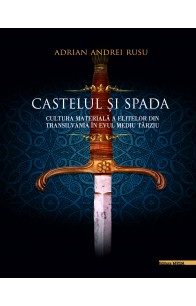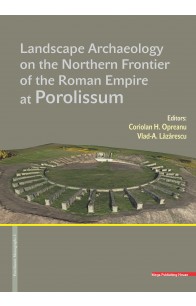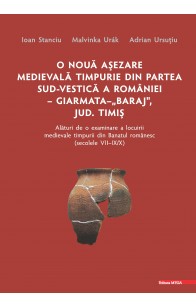Rezultate căutare pentru 'Adrian Ursu��iu'
Volumul este o sinteză a istoriografiei medievale care pune accentul pe cultura materială a elitelor din Transilvania în perioada Evului Mediu.
Această lucrare surprinde pentru început apariția elitelor și a centrelor de producție a bunurilor din Transilvania Evului Mediu, continuând mai apoi cu locurile unde își desfășurau activitatea elitele, ca în final să se concentreze pe averi și familiile de materiale, respectiv bunuri.
Autorul concluzionează ferm faptul că Evul Mediu „pus sub lupă nu este nici întunecat, nici misterios, nici murdar, nici fără zestre ori bunătăți.”
Adrian Andrei Rusu: „Dorința autorului ar fi aceea de a nu lăsa ca cele aici sintetizate să prindă mucegai și să se transforme într-un tratat. Ar vrea să fie mai ales deschideri de uși. Ele cer reluate, criticate ori dezvoltate pentru a-și îndeplini menirea pentru care au fost scrise.”
„The frontiers of the Roman Empire, over 5000 km long, stretch from the Atlantic coast of Scotland, along the Rhine and the Danube, also enclose the Banat region and Transylvania, then going down along the Oriental Carpathians to the Black Sea; from the southern coast of the Black Sea they continue towards the Near East until the Red Sea; then, in North Africa, they line the edge of the Sahara desert until the Atlantic coast of Morocco. Over this entire area, visible traces of fortifications, roads and settlements are still preserved, but numerous monuments still lay hidden underneath the earth. Despite the fact that the Roman frontiers crossed regions with different relief and climate, they constitute a whole in that they were designed to protect Roman territories. The research of these monuments and the preservation policy regarding them was and is unequal in the various presentday states on whose territory traces of the Roman frontier are to be found. Consequently, in the ‘80s of the 20th century, the idea of globally protecting the Roman frontiers, viewed as a unitary monument, was met. In 1987, Hadrian’s Wall in United Kingdom was declared a UNESCO monument. It was followed in 2005 by the German-Raetian sector, on which occasion the UNESCO committee decided to set up the ‘Frontiers of the Roman Empire’ site. (...)
This project through its complexity generated an interdisciplinary approach of the proposed subject stimulating such future attempts in the archaeological research field. By using the latest technical methods of non-destructive investigation the project did not damage the stratigraphy of the archaeological site obtaining instead a high amount of data otherwise time consuming judging from the archaeological excavations perspective contributing also to the preservation of the cultural heritage.” - Introduction
SOMMAIRE
Alexander Baumgarten, Le reste comme problème de la philosophie
I. Figurer le reste
Luigi Tassoni, La poetica delle somiglianze. Milo De Angelis dalle rovine del soggetto alle tracce del riconoscimento
Corin Braga, Le centre structurel et ses restes
Giovanni Rotiroti, Per una poetica e una politica dei resti a partire da Urmuz: il caso di Tristan Tzara, Eugène Ionesco, Paul Celan e Gherasim Luca
Antonio Patraș, The Anecdote in The History of Romanian Literature from Its Origins to the Present
Ligia Tudurachi, « Jouets », « boîtes », « reliques ». Fascination du petit chez Hortensia Papadat-Bengescu
George Alexandru Condrache, The Residual Forms in Contemporary Central European Literature. Two Case Studies: Bohumil Hrabal and Ádám Bodor
II. Le continent de la non-lecture
Horea Poenar, Glitches of the Archive: On the Relation Between Memory and the Commons
Catherine Gravet, Dépouiller des archives pour éditer des textes « résiduels » : le cas Alexis Curvers
Florin Oprescu & Monica Oprescu, Mateiu Caragiale – Through the Leftovers’ Glass. From the Journal to Ephemerides
Gabriela Glăvan, Communist Leftovers: The Forgotten Books of Gellu Naum
Eugen Radu Wohl, Ion D. Sîrbu’s Anthumous Works as (Re)valuable Residues
Levente T. Szabó, Dilettantism as a Moral Panic. Recovering a Forgotten Discourse of Hungarian Literary Modernization]
Corina Croitoru, Le résidu du résidu : ombres de la poésie roumaine de guerre
Roxana Patraș, When All That Rests Is Literature: Traces, Transcriptions and Remnants of Great Speeches
Arina Neagu, Une autre approche sur les mémoires roumains de prison : le caractère résiduel de « l’indicible concentrationnaire »
Barbara Miceli, How to Turn a Forgotten Figure of American History into a National and Gender Emblem: Joyce Carol Oates’s Treatment of Mary Jo Kopechne in Black Water
III. Identités en marge
Marie Vrinat-Nikolov, Les langues ignorées de l’espace littéraire bulgare
Annalisa Cosentino, La boemia altrove
Marius Popa, Le classicisme français dans la critique littéraire de la génération roumaine de 1848. Radiographies d’un « malentendu »
Lavinia Sabou, The Travel Accounts We Don’t Write About. Eastern European Ways of Mapping the World
Ruxandra Cesereanu, Societal Metabolism and “Excretion”: Towards a Typology of Marginals (The Fiction of Venedikt Yerofeyev, Alexander Zinoviev and Roberto Bolaño)
IV. Survivances
Monica Fekete, La rigenerazione del poema cavalleresco: da centro epico-narrativo a margine del moderno, da trionfo idealistico a spazio del romanzo contemporaneo
Laura Marin, Survivances du neutre
Márta Zabán, Residual Nationalism. The Nineteenth-Century Hungarian Folk Drama as a Reinterpretation of European Theatrical Nationalism. Pour une politique du résiduel en littérature
Ioana Bot, Gli esordi dimenticati della stilistica: Leo Spitzer, censore dei soldati italiani nei campi di prigionia della Prima Guerra Mondiale
Elena Crașovan, (Mis)readings of Contemporary Magical-Realist Fiction in the Context of Romania’s 2000 Literary Generation. The Case of Bogdan Popescu
Adriana Stan, Monuments of Literature, Scraps of Criticism
V. Entretiens: Ioana Bot, What’s Left? A Discussion on the Remains of Writing – and the Remains of Living – with Two European Authors
Link -> http://www.z-studarch.ro/
CONTENTS
Octavian Cristian Rogozea
Discoveries Attributed to the Early Vinča Phase in Tărtăria “Gura Luncii” (Alba County). The 214 Preventive Archaeological Researches Performed on “Site 10B”
Georgeta El Susi
Animal Bones from the Neolithic (Szakalhat) Levels at Uivar (Timiş County)
Victor Sava, Florin Mărginean, Adrian Ursuţiu
The Eneolithic Cemetery in Pecica “Est” (Arad County)
Tünde Horváth
Budakalasz, ein besonderer Bestattungsplatz der Badener Kultur. Kritische Anmerkungen zum Buch: Maria Bondar – Pal Raczky (Red.): The Copper Age cemetery of Budakalasz
Tobias L. Kienlin, Klára P. Fischl, Liviu Marta
Exploring Divergent Trajectories in Bronze Age Landscapes: Tell Settlement in the Hungarian Borsod Plain and the Romanian Ier Valley
Călin Ghemiș
The Late Bronze Age Gold Ring Discovered in Betfia (Bihor County, Romania)
Liliana Daniela Mateescu-Suciu
Glass Recipients from Sarmizegetusa Regia. Unguentaria and Bottles
Horațiu Cociș
The Rural Landscape of the Frontier of Dacia Porolissensis. A Case Study: the Northern Sector –
territorium Arcoba(da)rense – The Valley of River Someșul Mare
Norbert Kapcsos
Sarmatian graves from Pecica Site 18. Remarks upon the phenomenon of „isolated” graves from the Cris-Tisa-Mures region
Ioan Stanciu
On Early Medieval Roasting Trays and their Presence in the Settlements from the North-Western Part of Romania
Călin Cosma, Adrian Bolog, Ovidiu Oargă
Avar Graves Recently Discovered in Gambaș (Alba County) on the Spot Called “Ogoarele de jos”
Dan Băcueț-Crișan, Gruia Fazecaș, Doru Marta
An Early Medieval Feature Discovered in Oradea – Salca “Ghețărie” (Petrom Gas Station)
Daniela Tănase, Gábor Bertók, Anita Kocsis, Balázs Major
The location of Egres Cistercian monastery – Igriş (Timiș County), in the light of recent geophysical research
Florin Mărginean, Zsolt Csók, Keve László, Victor Sava
Unveiling History. Archaeological Excavations in the Fortress of Ineu (Arad County)
Dorel Micle, Bogdan Alin Craiovan, Andrei Stavilă, Octavian-Cristian Rogozea
The Times before Fischer’s Furniture Store. The Preventive Archaeological Researches in Sfântul Gheorghe Square 2–3, Timișoara (Timiş County)
Andrea Demjén, Florin Gogâltan
The Ciuc-Ghimeș Quarantine (18th–19th Centuries). Archaeological Researches of the Former Customs Point “Cetatea Rakoczy”
Abbreviations
„A rămas destul de puţin cunoscută evoluţia locuirii medievale timpurii din partea românească a Banatului, cu presupuse schimbări intervenite în decursul vremii, alături de eventuale tendinţe și aspecte specifice. În lipsa altor surse la îndemână, fără îndoială că noi contribuţii sunt de așteptat din partea arheologiei. În ultimele trei decenii, rolul decisiv a revenit săpăturilor preventive, într-o măsură sau alta fiind investigate și în acest spaţiu noi situri, din păcate cu rezultate doar semnalate, cazul celor mai multe dintre ele. Cel de la Giarmata–Baraj a fost identificat în anul 2011 pe traseul Autostrăzii Timișoara–Lugoj, urmând la scurt timp cercetarea arheologică preventivă, susţinută de un colectiv al Institutului de Arheologie și Istoria Artei al Academiei Române din Cluj-Napoca.” (din „Cuvânt-înainte”)







